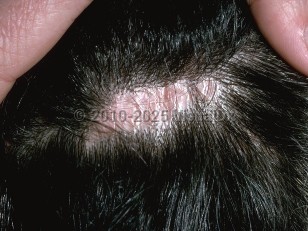Lichen planopilaris - Hair and Scalp
Alerts and Notices
Important News & Links
Synopsis

Lichen planopilaris (LPP), also referred to as follicular lichen planus (LP), lichen follicularis, and lichen planus acuminatus, is characterized by perifollicular erythema and scale that can progress to cicatricial (scarring) alopecia over time. As in lichen planus, LPP is thought to be caused by dysfunction in cell-mediated immunity. In LPP, the immune privilege of the hair follicle bulge is felt to be lost, resulting in loss of hair stem cells after attack by activated T-lymphocytes targeting follicular antigens and an inability of hair to regrow. LPP may present in association with LP, although it is often seen alone. LPP affects women more commonly than men. Those with lighter skin colors are more often affected than individuals with darker skin colors. The onset of LPP is frequently between age 40 and 60, although the condition has been described in children. LPP is very uncommon in children.
The condition may have an insidious or fulminant onset with hair loss in variable patterns. There are several variants of LPP: classic LPP, frontal fibrosing alopecia, and Graham-Little-Piccardi-Lassueur (Graham-Little) syndrome. Classic LPP presents with follicular violaceous erythema and perifollicular fine scale. Interfollicular erythema may also be seen, and in severe cases, confluent scale may be evident. The perifollicular erythema is usually seen at the periphery of patches of alopecia, which corresponds to active areas of disease. As the disease progresses, permanent cicatricial alopecia or Brocq alopecia occurs. Frontal fibrosing alopecia, as the name implies, clinically appears as a band-like scarring alopecia of the frontal hairline that commonly affects women. Graham-Little syndrome consists of the triad of cicatricial alopecia of the scalp, a lichenoid follicular eruption, and noncicatricial pubic and axillary hair loss. In addition, a diffuse variant was recently described. It presents with diffuse scalp itching with widespread hair thinning and erythema. This variant has no predilection by sex.
Increased hair shedding, severe itching, scaling, burning, and tenderness are common symptoms associated with LPP.
Related topics: lichenoid drug eruption, oral lichen planus
The condition may have an insidious or fulminant onset with hair loss in variable patterns. There are several variants of LPP: classic LPP, frontal fibrosing alopecia, and Graham-Little-Piccardi-Lassueur (Graham-Little) syndrome. Classic LPP presents with follicular violaceous erythema and perifollicular fine scale. Interfollicular erythema may also be seen, and in severe cases, confluent scale may be evident. The perifollicular erythema is usually seen at the periphery of patches of alopecia, which corresponds to active areas of disease. As the disease progresses, permanent cicatricial alopecia or Brocq alopecia occurs. Frontal fibrosing alopecia, as the name implies, clinically appears as a band-like scarring alopecia of the frontal hairline that commonly affects women. Graham-Little syndrome consists of the triad of cicatricial alopecia of the scalp, a lichenoid follicular eruption, and noncicatricial pubic and axillary hair loss. In addition, a diffuse variant was recently described. It presents with diffuse scalp itching with widespread hair thinning and erythema. This variant has no predilection by sex.
Increased hair shedding, severe itching, scaling, burning, and tenderness are common symptoms associated with LPP.
Related topics: lichenoid drug eruption, oral lichen planus
Codes
ICD10CM:
L66.11 – Classic lichen planopilaris
SNOMEDCT:
64540004 – Lichen planopilaris
L66.11 – Classic lichen planopilaris
SNOMEDCT:
64540004 – Lichen planopilaris
Look For
Subscription Required
Diagnostic Pearls
Subscription Required
Differential Diagnosis & Pitfalls

To perform a comparison, select diagnoses from the classic differential
Subscription Required
Best Tests
Subscription Required
Management Pearls
Subscription Required
Therapy
Subscription Required
References
Subscription Required
Last Reviewed:02/01/2021
Last Updated:05/28/2024
Last Updated:05/28/2024
 Patient Information for Lichen planopilaris - Hair and Scalp
Patient Information for Lichen planopilaris - Hair and Scalp
Premium Feature
VisualDx Patient Handouts
Available in the Elite package
- Improve treatment compliance
- Reduce after-hours questions
- Increase patient engagement and satisfaction
- Written in clear, easy-to-understand language. No confusing jargon.
- Available in English and Spanish
- Print out or email directly to your patient
Upgrade Today

Lichen planopilaris - Hair and Scalp

